
Clarksburg is a city in and the county seat of Harrison County, West Virginia, United States, in the north-central region of the state. The population of the city was 16,039 at the 2020 census, making it the tenth-largest city in West Virginia. It is the principal city of the Clarksburg micropolitan area, which had a population of 90,434 in 2020. Clarksburg was named National Small City of the Year in 2011 by the National League of Cities.
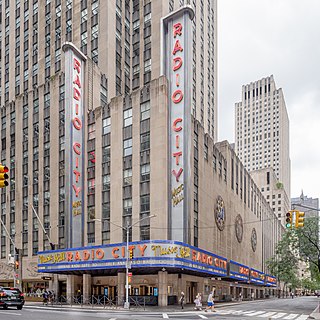
Radio City Music Hall is an entertainment venue and theater at 1260 Avenue of the Americas, within Rockefeller Center, in the Midtown Manhattan neighborhood of New York City. Nicknamed "The Showplace of the Nation", it is the headquarters for the Rockettes. Radio City Music Hall was designed by Edward Durell Stone and Donald Deskey in the Art Deco style.

The Fox Theatre is a performing arts center located at 2211 Woodward Avenue in Downtown Detroit, Michigan, near the Grand Circus Park Historic District. Opened in 1928 as a flagship movie palace in the Fox Theatres chain, it was at over 5,000 seats the largest theater in the city. Designed by theater architect C. Howard Crane, it was listed on the National Register of Historic Places in 1985.

The Stanley Theater at Kennedy Boulevard and Pavonia Avenue is near Journal Square in Jersey City, New Jersey.

The Keith-Albee Theatre is a performing arts center in downtown Huntington, West Virginia, United States. It was named after the Keith-Albee-Orpheum Corporation, one of the leading traveling vaudeville performance companies of the early 20th century, in an effort to convince the corporation's directors to make Huntington a regular stop.

The Orpheum Theatre, a 2,308-seat venue listed on the National Register of Historic Places, is located in downtown Memphis, Tennessee, on the southwest corner of the intersection of South Main and Beale streets. The Orpheum, along with the Halloran Centre for Performing Arts & Education, compose the Orpheum Theatre Group, a community-supported nonprofit corporation that operates and maintains the venues and presents education programs.
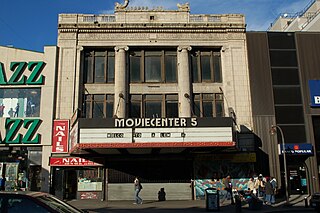
The Victoria Theater was a theater located on 125th Street in the Harlem neighborhood of Manhattan in New York City. It was designed in 1917 by Thomas W. Lamb, a notable and prolific theater architect of the era, for the Loew's Corporation. It was largely demolished in 2017, with the facade and lobby retained as part of a new mixed-use skyscraper, the tallest building in Manhattan north of Central Park.

An atmospheric theatre is a type of movie palace design which was popular in the late 1920s. Atmospheric theatres were designed and decorated to evoke the feeling of a particular time and place for patrons, through the use of projectors, architectural elements and ornamentation that evoked a sense of being outdoors. This was intended to make the patron a more active participant in the setting.
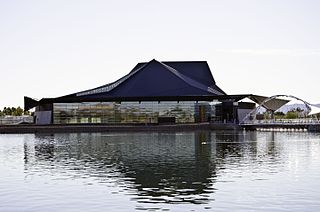
Tempe Center for the Arts (TCA) is a publicly owned performing and visual arts center in Tempe, Arizona. It opened in September 2007 and houses a 600-seat proscenium theater, a 200-seat studio theater, and a 3,500-square-foot gallery. Its Lakeside Room seats 200 people and overlooks Tempe Town Lake, with views of the Papago Buttes and Camelback Mountain.
The Capitol Theatre is a theatre operating in Rome, New York. It opened December 10, 1928 as part of the Kallet chain of movie houses, presenting first run films until it closed in 1974. After extensive renovation, the theatre re-opened in 1985 as the non-profit Capitol Civic Center, offering classic films, live theatrical performances, and concerts.

The Rialto Center for the Arts is an 833-seat performing-arts venue owned and operated by Georgia State University and located in the heart of the Fairlie-Poplar district in downtown Atlanta, Georgia. The venue is home to the Rialto Series, an annual subscription series featuring national and international jazz, world music, and dance. The Rialto also routinely presents Georgia State University School of Music performances, the annual National Black Arts Festival, and many others.

The Standard Theatre, now known as the Folly Theater and also known as the Century Theater and Shubert's Missouri, is a former vaudeville hall in downtown Kansas City, Missouri. Built in 1900, it was designed by Kansas City architect Louis S. Curtiss. The theater was associated with the adjoining Edward Hotel, which was also designed by Curtiss; the hotel was demolished in 1965.

The Oriental Theatre was a movie theater located at 828 SE Grand Street in the East Portland commercial district of Portland, Oregon that was built in 1927. The Oriental was a 2,038-seat movie palace designed by Lee Arden Thomas and Albert Mercier. The building's exterior was in the Italian Renaissance style. The interior had an "almost surreal appearance" created by interior designer Adrien Voisin. It was built by George Warren Weatherly. Demolished in 1970, the theater was adjacent to the Weatherly Building, which remains standing.
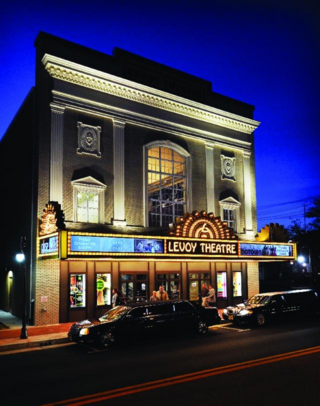
The Levoy Theatre is a 696-seat operational performing arts center located in Millville, Cumberland County, New Jersey, United States.

The Mississippi Lofts and Adler Theatre is an apartment building and theater complex located in downtown Davenport, Iowa, United States. It is individually listed on the National Register of Historic Places by its original name, the Hotel Mississippi and RKO Orpheum Theater. The Hotel Mississippi was listed on the Davenport Register of Historic Properties in 2005. In 2020 the complex was included as a contributing property in the Davenport Downtown Commercial Historic District.

BiddefordCity Theater is a year-round near 500-seat, restored Victorian opera house at 205 Main Street in Biddeford, Maine, United States. Biddeford City Theater is a non-profit, volunteer-driven, organization that produces and hosts plays, musicals, concerts, movies, music, comedy, and other artistic performances with patrons from all over New England. The mission of City Theater Associates is to foster an appreciation for the performing arts by using creative avenues to increase community involvement.

The RKO Keith's Theater was an RKO Pictures movie theater at 135-35 Northern Boulevard in the Flushing neighborhood of Queens in New York City. It was designed by architect Thomas W. Lamb and built in 1928. While the RKO Keith's had a plain three-story facade, its interior was elaborately designed in a Spanish Baroque Revival style. The theater had a square ticket lobby and an oval grand foyer, which led to the double-level auditorium. The auditorium was designed as an atmospheric theater with a blue ceiling and gilded-plaster decorations; it contained 2,974 seats across two levels. There were also four lounges and a mezzanine promenade.
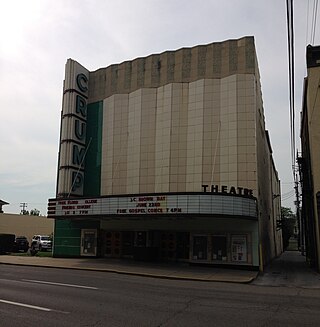
The Crump Theatre is located in downtown Columbus, Indiana, at 425 Third Street, is part of the Columbus Historic District, which is listed on the National Register of Historic Places. The theatre is owned by the Columbus Capital Foundation and periodically used as an event space for a variety of acts, including musicians, comedians, and paranormal investigators.

The Waldo Hotel in Clarksburg, West Virginia was built between 1901 and 1904 by real estate developer, U.S. Senator, Congressman, judge, lawyer, and Republican Party leader Nathan Goff, Jr. Built right across from his family home which is also still standing and currently used as a library called Waldomore, and Named for his father, Waldo P. Goff. Clarksburg was experiencing a period of rapid growth in the late 19th and early 20th centuries, driven by the booming coal industry. Goff Jr. saw the hotel as a way to attract new businesses and residents to the city, further solidifying its position as a regional hub. Goff Jr. was a man of considerable wealth and ambition. He envisioned the Waldo Hotel as a symbol of his own success and a testament to his family's legacy in Clarksburg. Clarksburg lacked a large, upscale hotel to accommodate its growing business traveler population and social events. The Waldo Hotel was designed to fill this gap and provide a luxurious venue for meetings, banquets, and other gatherings.

Ernest C. S. Holmboe (1873–1954) was an American architect best known for his work in West Virginia.






















